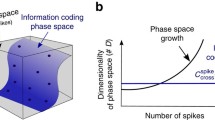Abstract
Several binless spike train measures which avoid the limitations of binning have been recently been proposed in the literature. This paper presents a systematic comparison of these measures in three simulated paradigms designed to address specific situations of interest in spike train analysis where the relevant feature may be in the form of firing rate, firing rate modulations, and/or synchrony. The measures are first disseminated and extended for ease of comparison. It also discusses how the measures can be used to measure dissimilarity in spike trains' firing rate despite their explicit formulation for synchrony.










Similar content being viewed by others
Explore related subjects
Discover the latest articles, news and stories from top researchers in related subjects.Notes
Filtered spike trains correspond to what is often referred to as “shot noise” in the point processes literature [32, Sect. 16.3].
References
Victor JD, Purpura KP (1996) Nature and precision of temporal coding in visual cortex: a metric-space analysis. J Neurophysiol 76(2):1310–1326
Victor JD, Purpura KP (1997) Metric-space analysis of spike trains: theory, algorithms, and application. Netw Comp Neural Syst 8:127–164
Wohlgemuth S, Ronacher B (2007) Auditory discrimination of amplitude modulations based on metric distances of spike trains. J Neurophysiol 97:3082–3092. doi:10.1152/jn.01235.2006
Houghton C (2009) Studying spike trains using a van Rossum metric with a synapse-like filter. J Comp Neurosci 26:149–155. doi:10.1007/s10827-008-0106-6
Brown EN, Kass RE, Mitra PP (2004) Multiple neural spike train data analysis: state-of-the-art and future challenges. Nature Neurosci 7:456–461. doi:10.1038/nn1228
Dayan P, Abbott LF (2001) Theoretical neuroscience: computational and mathematical modeling of neural systems. MIT Press, Cambridge
Rieke F, Warland D, van Steveninck RR, Bialek W (1999) Spikes: exploring the neural code. MIT Press, Cambridge. ISBN 0-262-18174-6
Mainen ZF, Sejnowski TJ (1995) Reliability of spike timing in neocortical neurons. Science 268(5216):1503–1506. doi:10.1126/science.7770778
Hatsopoulos NG, Ojakangas CL, Paninski L, Donoghue JP (1998) Information about movement direction obtained from synchronous activity of motor cortical neurons. Proc Natl Acad Sci 95(26):15706–15711
Wagner H, Brill S, Kempter R, Carr CE (2005) Microsecond precision of phase delay in the auditory system of the barn owl. J Neurophysiol 94(2):1655–1658. doi:10.1152/jn.01226.2004
Eggermont JJ (2006) Properties of correlated neural activity clusters in cat auditory cortex resemble those of neural assemblies. J Neurophysiol 96(2):746–764. doi:10.1152/jn.00059.2006
Riehle A, Grün S, Diesmann M, Aertsen A (1997) Spike synchronization and rate modulation differentially involved in motor cortical function. Science 278(5345):1950–1953. doi:10.1126/science.278.5345.1950
Grün S, Diesmann M, Aertsen A (2002) Unitary Events in multiple single-neuron activity. I. detection and significance. Neural Comp 14(1):43–80
Grün S, Diesmann M, Aertsen A (2002) Unitary Events in multiple single-neuron activity. II. nonstationary data. Neural Comp 14(1):43–80
Grün S, Diesmann M, Grammont F, Riehle A, Aertsen A (1999) Detecting unitary events without discretization of time. J Neurosci Methods 93(1):67–79. doi:10.1016/S0165-0270(99)00126-0
van Rossum MCW (2001) A novel spike distance. Neural Comp 13(4):751–764
Schreiber S, Fellous JM, Whitmer D, Tiesinga P, Sejnowski TJ (2003) A new correlation-based measure of spike timing reliability. Neurocomp 52–54:925–931. doi:10.1016/S0925-2312(02)00838-X
Kreuz T, Haas JS, Morelli A, Abarbanel HDI, Politi A (2007) Measuring spike train synchrony. J Neurosci Methods 165(1):151–161. doi:10.1016/j.jneumeth.2007.05.031
Hunter JD, Milton JG (2003) Amplitude and frequency dependence of spike timing: Implications for dynamic regulation. J Neurophysiol 90(1):387–394. doi:10.1152/jn.00074.2003
Aronov D, Reich DS, Mechler F, Victor JD (2003) Neural coding of spatial phase in V1 of the macaque monkey. J Neurophysiol 89(6):3304–3327. doi:10.1152/jn.00826.2002
Aronszajn N (1950) Theory of reproducing kernels. Trans Am Math Soc 68(3):337–404
Houghton C, Sen K (2008) A new multineuron spike train metric. Neural Comp 20(6):1495–1511. doi:10.1162/neco.2007.10-06-350
Victor JD (2005) Spike train metrics. Curr Opin Neurobiol 15(5):585–592. doi:10.1016/j.conb.2005.08.002
Fellous J-M, Tiesinga PHE, Thomas PJ, Sejnowski TJ (2004) Discovering spike patterns in neuronal responses. J Neurosci 24(12):2989–3001. doi:10.1523/JNEUROSCI.4649-03.2004
Paiva ARC, Rao S, Park I, Príncipe JC (2007) Spectral clustering of synchronous spike trains. In: Proceedings of the IEEE international joint conference on neural networks, IJCNN-2007, Orlando, FL, USA
Toups JV, Tiesinga PHE (2006) Methods for finding and validating neural spike patterns. Neurocomputing 69(10–12):1362–1365
Schrauwen B, Van Campenhout J (2007) Linking non-binned spike train kernels to several existing spike train distances. Neurocomputing 70(7–8):1247–1253. doi:10.1016/j.neucom.2006.11.017
Wang L, Narayan R, Graña G, Shamir M, Sen K (2007) Cortical discrimination of complex natural stimuli: can single neurons match behavior? J Neurosci 27(3):582–589. doi:10.1523/JNEUROSCI.3699-06.2007
Abeles M (1991) Corticonics: neural circuits of the cerebral cortex. Cambridge University Press, New York
Shadlen MN, Newsome WT (1994) Noise, neural codes and cortical organization. Curr Opin Neurobiol 4(4):569–579
de Ruyter van Steveninck RR, Lewen GD, Strong SP, Koberle R, Bialek W (1997) Reproducibility and variability in neural spike trains. Science 275:1805–1808
Papoulis A (1965) Probability, random variables, and stochastic processes. McGraw-Hill, New York
Reiss R-D (1993) A course on point processes. Springer, New York
Paiva ARC, Park I, Príncipe JC (2009) A reproducing kernel Hilbert space framework for spike train signal processing. Neural Comp 21(2):424–449. doi:10.1162/neco.2008.09-07-614
Pekalska E, Duin RPW (2005) The dissimilarity representation for pattern recognition: foundations and applications. World Scientific, Singapore. ISBN 9-812-56530-3
Duda RO, Hart PE, Stork DG (2000) Pattern classification, 2nd edn. Wiley Interscience
Adrian ED (1928) The basis of sensation: the action of the sense organs. W. W. Norton & Co., New York
Kuhn A, Aertsen A, Rotter S (2003) Higher-order statistics of input ensembles and the response of simple model neurons. Neural Comp 15(1):67–101
Kuhn A, Rotter S, Aertsen A (2002) Correlated input spike trains and their effects on the response of the leaky integrate-and-fire neuron. Neurocomputing 44–46:121–126. doi:10.1016/S0925-2312(02)00372-7
Narayan R, Graña G, Sen K (2006) Distinct time scales in cortical discrimination of natural sounds in songbirds. J Neurophysiol 96(1):252–258. doi:10.1152/jn.01257.2005
Author information
Authors and Affiliations
Corresponding author
Rights and permissions
About this article
Cite this article
Paiva, A.R.C., Park, I. & Príncipe, J.C. A comparison of binless spike train measures. Neural Comput & Applic 19, 405–419 (2010). https://doi.org/10.1007/s00521-009-0307-6
Received:
Accepted:
Published:
Issue Date:
DOI: https://doi.org/10.1007/s00521-009-0307-6




